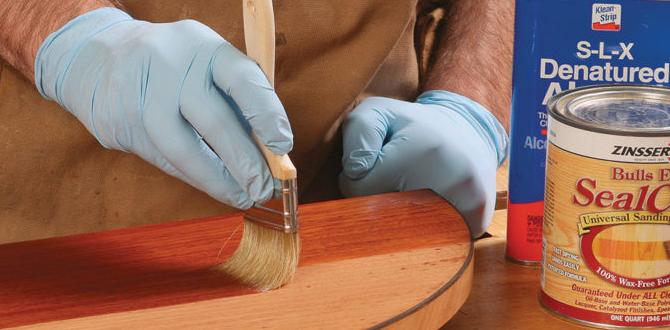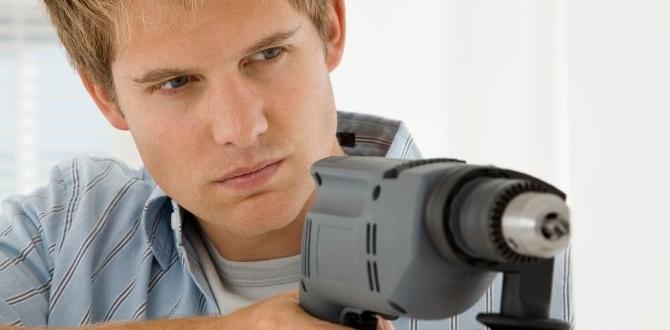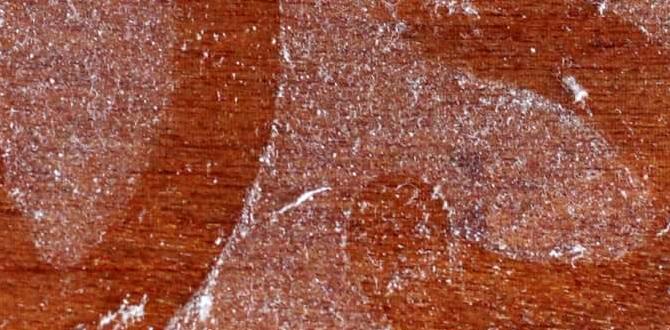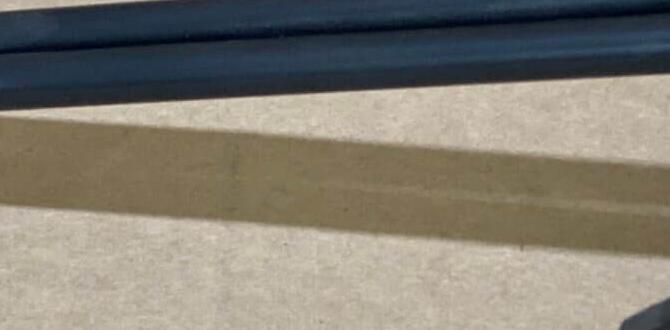Have you ever wondered if lacquer can keep your wood projects safe from water? Most people think it can. But is lacquer truly waterproof? Let’s dive into this question together!
Many crafters use lacquer because it gives a beautiful shine. It’s often seen on furniture, musical instruments, and even art pieces. But just how well does it protect against spills and splashes? Imagine spilling your drink on a freshly lacquered table. Wouldn’t it be nice to know that the finish would keep your table safe?
Here’s something surprising: not all lacquers are the same. Some might resist water better than others. This can be tricky for beginners. So, what should you choose? Keep reading to uncover the truth about lacquer and its relationship with water. You might just discover the best way to protect your favorite items!
Table of Contents
Is Lacquer Waterproof? Discover The Truth About Durability! Lacquer Is A Popular Finishing Material Used In Woodworking, Furniture, And Crafts. However, A Common Question Arises: **Is Lacquer Waterproof?** Understanding The Properties Of Lacquer, Especially Its Durability And Water Resistance, Is Essential For Anyone Looking To Use It For Protection Or Aesthetic Purposes. In This Article, We Will Explore The Truth About Lacquer’S Waterproof Capabilities, Its Advantages, And How It Compares To Other Finishes In Terms Of Moisture Resistance. What Is Lacquer? Lacquer Is A Fast-Drying Clear Or Colored Coating Typically Used For Wood And Metal. It Has Been A Favorite Among Woodworkers Because Of Its Durable Finish And Ability To Enhance The Natural Beauty Of The Materials. Lacquer Can Be Either Solvent-Based Or Water-Based, And The Type You Choose Can Impact Its Waterproof Properties. Is Lacquer Waterproof? The Answer To Whether Lacquer Is Waterproof Can Be A Bit Nuanced. While Lacquer Finishes Do Offer Some Level Of Water Resistance, They Are Not Completely Waterproof. Here Are Some Key Points To Consider: – **Water Resistance**: Lacquer Provides A Protective Layer That Can Withstand Exposure To Moisture To Some Extent. This Means It Can Resist Spills And Light Humidity, Making It Suitable For Use In Indoor Settings Where Direct Water Contact Is Minimal. – **Durability**: Lacquer Dries Quickly And Forms A Hard Finish, Which Can Help Protect Wood From Water Damage Compared To Untreated Surfaces. However, Prolonged Exposure To Water Can Cause The Finish To Break Down Over Time. – **Vulnerability**: If Lacquered Items Are Subjected To Consistent Moisture Or Are Outside In The Elements, The Finish May Fade Or Deteriorate, Leading To Peeling Or Discoloration. Therefore, It’S Not Recommended For Outdoor Furniture Or Surfaces That Will Frequently Encounter Water. Alternatives For Waterproofing If You’Re Looking For A Truly Waterproof Finish For Your Projects, Consider Alternatives Such As: – **Polyurethane**: Often More Water-Resistant Than Lacquer, Especially In Its Oil-Based Form. It Is Ideal For Surfaces Prone To Heavy Moisture. – **Epoxy**: Known For Creating A Hard Shell That Is Completely Waterproof, Making It Suitable For Both Indoor And Outdoor Applications. – **Marine Varnish**: Specifically Formulated To Withstand Water, It Is An Excellent Option For Boats And Outdoor Furniture. Conclusion In Conclusion, While Lacquer Is Not Completely Waterproof, It Does Offer Some Level Of Water Resistance And Durability. For Projects That May Come Into Contact With Moisture, It’S Crucial To Assess Your Specific Needs And Perhaps Consider Coatings That Provide A Higher Degree Of Protection. Always Remember To Follow Proper Application And Maintenance Practices To Maximize The Lifespan Of Your Lacquer Finish.

Is Lacquer Waterproof? Discover the Truth!
Lacquer often sparks questions about its waterproof abilities. Many assume it can resist water completely, but that’s not always true. While lacquer provides a strong finish, prolonged exposure to water can damage it. Surprised? It’s best used in dry areas or as a decorative finish. Imagine your beautiful furniture ruined by a spill! Knowing the limits of lacquer helps you protect your treasured items. So, can you trust it against moisture? The answer isn’t straightforward!
Understanding Lacquer: What Is It?
Definition of lacquer and its chemical composition. Different types of lacquer used in various applications.
Lacquer is a special type of shiny finish made from a mix of chemicals. It often contains resin and solvents, which give it those glossy looks. You might find lacquer on your favorite furniture or even your guitar! There are many types of lacquer. For example, nitrocellulose lacquer dries quickly, while water-based lacquer is better for the environment. Each type has its own special job, like a superhero with different powers!
| Type of Lacquer | Characteristics | Common Uses |
|---|---|---|
| Nitrocellulose | Fast-drying | Musical instruments |
| Water-based | Low odor | Furniture and crafts |
| Cellulose | Durable | Vehicles |
Water Resistance vs. Waterproof: Key Differences
Explanation of water resistance and waterproofing. Importance of understanding these terms in relation to lacquer.
Understanding the difference between water resistance and waterproofing is important, especially for lacquers. Water resistance means that a product can bead off water, but it may still get wet. Think of it like a raincoat: water may slide off, but it won’t keep you completely dry in a downpour. On the other hand, waterproof means that a material can withstand water completely without any damage. Lacquer can be tricky, as it may offer some protection but isn’t truly waterproof. So, if your lacquered item takes a swim, don’t expect it to float!
| Term | Definition |
|---|---|
| Water Resistance | Can repel water but not completely prevent it. |
| Waterproof | Completely impervious to water. |
Does Lacquer Provide a Waterproof Finish?
Analysis of lacquer’s properties regarding water exposure. Examination of how lacquer reacts to different moisture levels.
Lacquer is known for its shiny and protective finish. But what happens when water meets lacquer? Let’s break it down. Lacquer can resist light moisture but may not hold up well in heavy water exposure. Here’s a quick look at how it reacts:
- Light exposure: It can handle small spills.
- Moderate humidity: It stays strong in humid environments.
- Heavy water: Direct contact can cause damage.
So, while lacquer offers some protection, it’s not fully waterproof. For the best results, keep lacquered items away from water.
Does lacquer provide a waterproof finish?
No, lacquer is not completely waterproof. It can resist light moisture but struggles with heavy water exposure.
Factors Influencing Lacquer’s Water Resistance
Environmental conditions affecting lacquer durability. Quality of lacquer and application techniques.
Water can be tricky for lacquer! Several factors decide if it can stand up to a splash. First, environmental conditions play a huge role. Humidity, temperature, and exposure to sunlight can weaken lacquer. Even a tiny rain cloud can bring trouble!
The quality of lacquer matters too. High-quality lacquer can be like a superhero, fighting off water damage. But application techniques are just as important. A smooth, even coat is key! If you skip this step, your lacquer can end up looking like a bad haircut – all patchy and sad.
| Factor | Influence on Water Resistance |
|---|---|
| Environmental Conditions | Humidity and UV rays can weaken lacquer. |
| Quality of Lacquer | Higher quality means better protection against water. |
| Application Techniques | Even coats help create a strong barrier. |
Remember, treat your lacquer like a delicate flower, and it will blossom beautifully – even in the rain!
Application Tips for Achieving Water Resistance with Lacquer
Best practices for applying lacquer to ensure optimal performance. Recommended surface preparation methods for water resistance.
To get the best water resistance with lacquer, follow these tips:
- Choose the Right Surface: Always start with clean, dry surfaces. This helps the lacquer stick better.
- Prep the Surface: Sand the item lightly. This creates a rough surface for the lacquer to grab onto.
- Use Thin Coats: Apply several thin layers instead of one thick coat. Thin layers dry quicker and are stronger.
- Allow Proper Drying: Let each coat dry completely before adding the next. This improves durability.
Following these steps ensures your lacquer works well and resists water.
Is lacquer waterproof?
The answer is yes, but with conditions. Properly applied lacquer can provide good water resistance, yet it’s important to follow application tips for the best results.
Maintenance and Care for Lacquered Surfaces
Cleaning tips to maintain waterresistant properties. Signs of wear and when to reapply lacquer.
To keep your lacquered surfaces looking great, cleaning is key. Use a soft cloth and mild soap. Avoid harsh cleaners that might damage the finish. Here are some easy tips:
- Wipe spills quickly to prevent water damage.
- Regularly dust to prevent scratches.
- Use furniture polish for shine.
Watch for signs of wear, like dullness or peeling. If you notice these, it’s time to reapply lacquer for protection. Keeping your surfaces well-cared ensures they last.
How do you know when to reapply lacquer?
If you see dull spots or peeling paint, it’s time to recoat!
Common Misconceptions About Lacquer and Water Resistance
Debunking myths surrounding lacquer and its waterproof claims. Reallife examples and testimonies from users.
Many folks think lacquer is the superhero of wood finishes, especially when it comes to water. But not quite! Some believe lacquer makes surfaces completely waterproof. That’s a big myth! Real-life users have shared stories of water damage even with lacquered furniture. So, before you splash water on that fancy table, remember: lacquer can resist moisture, but it is not invincible.
| Misinformation | Reality |
|---|---|
| Lacquer is totally waterproof. | It resists water but can still be damaged by it. |
| All users have amazing experiences. | Many report issues after exposure to water. |
So next time, don’t let that water bottle rain on your lacquer parade!
Conclusion
In conclusion, lacquer is not fully waterproof. It can resist moisture but may not hold up against heavy water. You should consider additional sealants for maximum protection. Always check product labels before using lacquer in wet areas. For more details, explore guides on using lacquer and waterproofing techniques. Let’s keep our projects safe and beautiful!
FAQs
What Properties Of Lacquer Contribute To Its Waterproof Capabilities?
Lacquer is special because it forms a tough hard shell. This shell keeps water from getting through. It dries quickly and sticks well to surfaces. Because of this, it protects items from getting wet and damaged.
How Does The Durability Of Lacquer Compare To Other Waterproof Finishes, Such As Polyurethane Or Varnish?
Lacquer is very shiny and dries fast. It can wear out more quickly than polyurethane and varnish. Polyurethane is tougher and lasts longer, especially on floors. Varnish also lasts a while but takes longer to dry than lacquer. So, if you want something super strong and long-lasting, polyurethane is a better choice.
Can Lacquer Coatings Be Applied In Outdoor Environments Without Compromising Their Waterproof Effectiveness?
Yes, you can use lacquer coatings outside. But, you need to pick the right type. Some lacquers are made for outdoor use and can stay waterproof. Make sure to read the label before applying it. If you do it right, your items will be protected from water.
What Factors Can Affect The Waterproofness Of Lacquer Over Time, Such As Exposure To Sunlight Or Temperature Fluctuations?
Many things can change how waterproof lacquer is, like sunlight and temperature changes. Sunlight can make the lacquer break down and lose its strength. If the temperature goes up and down a lot, it can make the lacquer crack. Water can get in through those cracks, making the wood underneath not safe. Keeping lacquer away from strong sun and extreme heat can help it last longer.
How Should Lacquer-Coated Surfaces Be Maintained To Ensure Maximum Waterproof Protection?
To keep lacquer-coated surfaces waterproof, clean them regularly with a damp cloth. Avoid using harsh cleaners. You should also check for scratches or damage. If you see any, fix them quickly with a special lacquer repair kit. Lastly, keep the surface away from extreme heat or direct sunlight.





